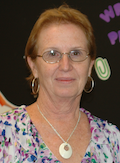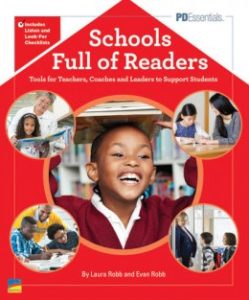How Schools Can Create Enthusiastic Readers
Schools Full of Readers: Tools for Teaches, Coaches, and Leaders to Support Students
By Laura Robb and Evan Robb
(Benchmark Education, 2020 – Learn more)

I have always loved to read since I was little. When I first started teaching, it was difficult for me to comprehend that there were students in my class who did not like to read. What could I do to reach them and show them the joy that reading brings you?
Of course, there were also students who were proficient at looking like they were avid readers but were merely page turners. Sadly, I hate to admit it, but when I started to teach, reading was mainly the sole purview of the reading or English teacher.
With persistence, research, and a desire to fill my classroom with books that appealed to my students, I was able to gain the reputation of being the teacher who could and would turn non-readers into readers.

Students reading and wanting to read. Teachers reading with their students and to their students. Backpacks and tablets full of stories that students had placed on their “I want to read this next” lists. Students texting their friends the titles of books they just finished reading.
Schools Full of Readers is the book that teachers, administrators, coaches, student teachers, and education professors have been searching for. The Robbs – mother Laura (the literacy consultant) and son Evan (the middle school principal) have published a book that should be in every school’s professional library (actually several copies should be purchased).
The authors have traveled far and wide, visiting classrooms and schools around the country. They have encountered potential roadblocks that could have detoured schoolwide reading programs and have found novel ways to circumvent problems.
They have written a book that will help tackle the questions of How do we get them to read? How do we get them to want to read? How do we get them to become lifelong readers? (And the answer is not giving out stickers, hosting pizza parties, or having a principal sleep overnight on the roof if a reading goal is met.)
The essentials: resources and time
As the authors point out, providing time and resources for independent reading is how you begin to improve your students’ skills, develop critical thinkers, improve fluency, and create an atmosphere where reading is contagious. Student choice is imperative. Before kids can tackle other texts, they need to master texts that interest them. “Students should read self-selected books for at least 10 to 15 minutes in pre-K and kindergarten and 20 to 25 minutes in grades 1 to 5.” (p. 51)
Given the typical scheduling in the upper grades it may be a bit difficult to set aside a prescribed block of independent reading time each day, but it can be done! In this book you will find novel and “doable” ways to have a school full of readers.
As teachers we are born creative thinkers and can certainly figure out a way to find the time. We want our students to transfer the love of reading in the classroom into reading at home. In this book, you will discover ways to instill the love of reading into your schools.
Roles for administrators, coaches and teachers
I found this book easy to read, full of ideas and research, including “Listen and Look for” checklists that will help coaches and administrators guide their staffs to develop a school-wide focus on joyful and purposeful reading.
Teachers will appreciate the authors’ premise that in order for this to happen, you need teacher input from all levels and subject areas. Midway through the book, I found this quotation: “It is the teachers within the school who often know the school’s aspirations and challenges best, and so it’s critical that their voices are heard.” (p. 69) Amen to that!!
An easy-to-use book from wise and committed educators
I was very impressed with the book: the format, the information, the real-life experiences that the authors shared, the checklists. The text is easy to read, encourages self reflection and collaboration, and is “doable.” I could go on and on about how fantastic this book is, especially Chapter 5: Supporting Readers’ Independence where Evan and Laura Robb give you a true glimpse into what reading can look like in your classroom.
This chapter reviews the heart of Readers Workshop, from teaching children how to find a “good fit” book, to managing time, and listening to your students as they discuss their books. The Robbs won the gold medal from me when I turned a page and saw that they had an extensive section on Interactive Read-aloud Lessons. It was complete with text from Ruby Bridges by Lesli J. Favor, lesson planning, anchor charts, “reading the pictures,” using sticky notes, and more.
As I read this book, I could feel the passion that Laura and Evan Robb have for teaching and for helping our students become the best readers they can be. This book will help develop students as life-long readers. Children will be asking to download books instead of video games on their iPads or asking for a ride to the nearest book store instead of going to the movies.
What the Robbs have done so well is to share their experiences as researchers and as educators and provide detailed procedures and insights to guide you on your journey. Their use of anecdotes from the field makes the material relatable and easy to understand. I loved the conversational tone intermingled with the practical applications from actual classrooms. This book will transform your teaching, your students as readers, and your school culture.
After teaching fourth and fifth graders for many years, Linda Biondi is supervising preservice and student teachers at The College of New Jersey and Rider University. Last summer she co-facilitated a week-long writing institute in conjunction with the National Writing Project at Rider University. She volunteers for two service organizations: Homefront and Dress for Success of Central New Jersey – both have a mission to end poverty and homelessness. The mission of Dress for Success is to empower women to achieve through economic independence.
































Reading interest covers a wish, ability and activity to read. To improve reading interest among students, we can use Pull Strategy. This strategy aims to attract students into coming to the physical or virtual library. According this article at the University of Airlangga (Indonesia) website, Pull Strategy is implemented through some steps, such as by having more activities or events in the library.
Reading is the foundation of all subjects. In order to succeed as a student, you must be able to read. As a teacher, encouraging students to read is critical. When a child is inspired to read, that is true education. Schools Full of Readers: Tools for Teachers, Coaches, and Leaders to Support Students is a wonderful resource. I deeply appreciate this review: thank you Laura Robb and Evan Robb for an insightful read.